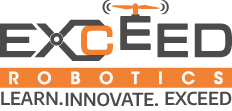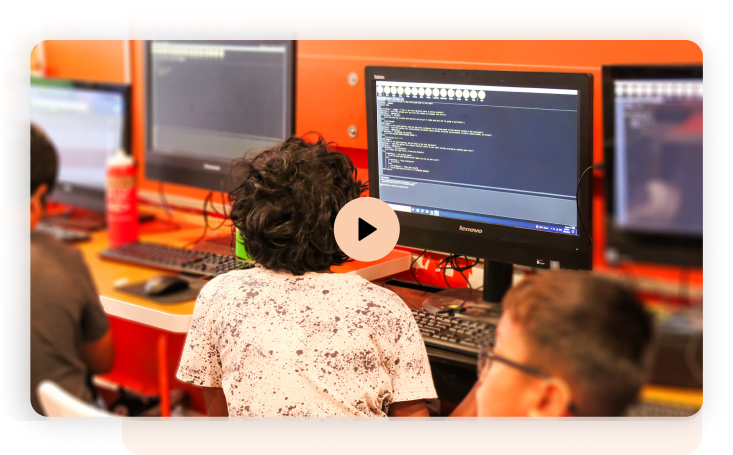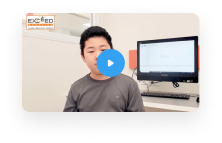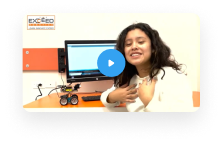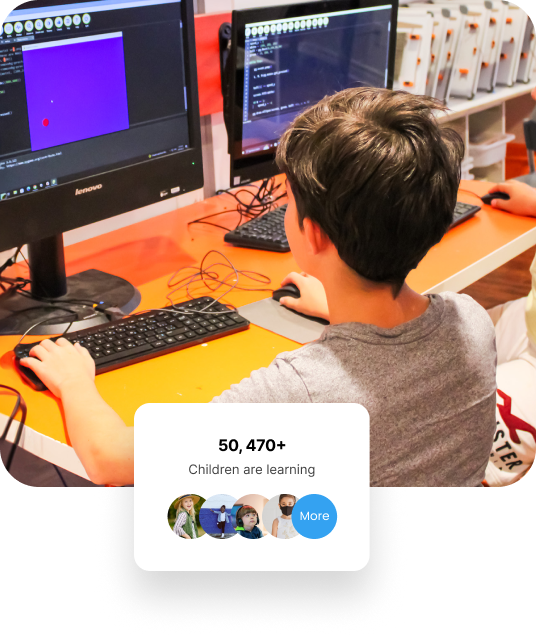
What Your Child will Learn
Coding
Students learn Python language, one of the most versatile languages in a fun way: Creating Games. Python uses English phrases which makes it easier for kids to learn.
Artificial intelligence
Another application which teaches students is Artificial Intelligence using Python Language. Students use face recognition and voice commands in advanced coding course.
Math Skills
Learning math can be really fun when creating games. Topics such as coordinate systems, mathematical operations and matrices are examples of what kids can learn while coding games.
Preparing for the future
Computer Science is one of the most in-demand programs offered in most universities. Students who show interest in coding are very likely to pursue further education in related field.
What Your Child will Learn
Coding
Students learn Python language, one of the most versatile languages in a fun way: Creating Games. Python uses English phrases which makes it easier for kids to learn.
Artificial intelligence
Another application which teaches students is Artificial Intelligence using Python Language. Students use face recognition and voice commands in advanced coding course.
Math Skills
Learning math can be really fun when creating games. Topics such as coordinate systems, mathematical operations and matrices are examples of what kids can learn while coding games.
Preparing for the future
Computer Science is one of the most in-demand programs offered in most universities. Students who show interest in coding are very likely to pursue further education in related field.
Request your free trial
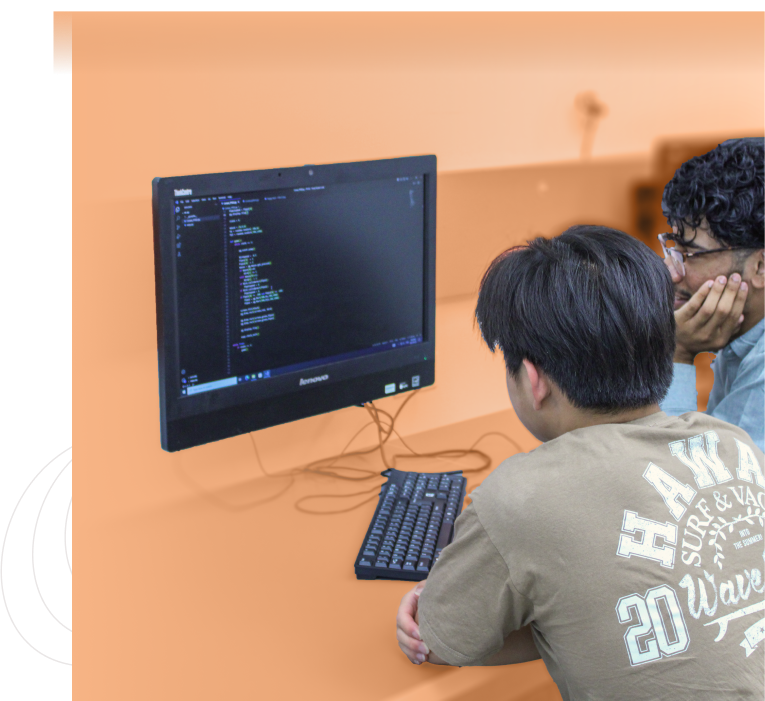
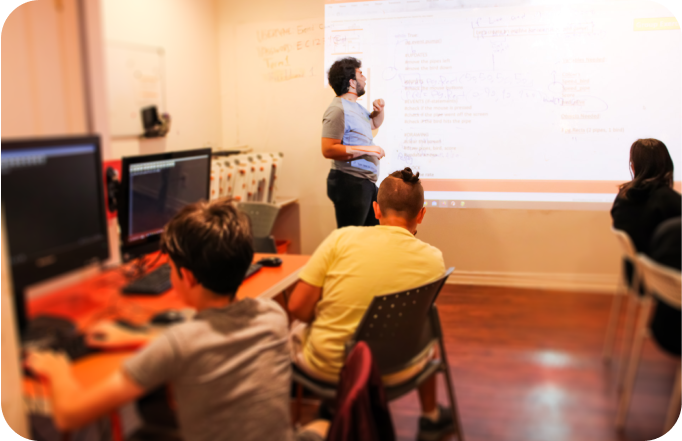

Why Exceed ?
Trained Instructors
Our instructors undergo thorough training to ensure children receive an exceptional learning experience
Hands-on STEM Projects
At Exceed, we believe that fun is an integral part of the learning journey. Our students have access to a range of hands-on learning opportunities
Small Student Ratio
To ensure exceptional student experience, we maintain 6:1 student to instructor ratio
Here’s how it works
Register for a free class trial
Offered every week at all locations in GTA. This 1-hour hands-on class gives your child a glimpse of Robot Programming.
Get a schedule for the upcoming term
We offer classes on various days and times to help you choose the schedule that works best for you. This is often the most challenging step!
Enroll in coding curriculum
Once you have selected a preferred day and time for the program, you are all set. You just need to wait until it begins, but don't worry, once you start you don't have to stop.
Courses
This program is designed to introduce students to coding in Python through a fun application - Game Programming. Students learn programming fundamentals using an object-oriented language. Concepts such as variables, if statements, while loops, mouse input, and basic shapes are taught in the first course. Students conclude the course by designing and programming a game in Python, using their newly acquired skills.
Students are introduced to more advanced concepts including Functions, Lists and Keyboard input. The material covered in this course could be extended to any object-oriented programming language and serve to advance our game development skills. Students will complete the course by creating a new game and applying the learned fundamentals.
Our third game programming course focuses on one of the most important concepts of object-oriented programming - classes. Classes play a big role in game programming by simplifying code and have extensive uses in non-game programming applications. Students will create several games throughout this course to better understand and practice this concept.
The final Game Programming course has an open project to provide students with the opportunity to apply the learned concepts for programming a game on their own. Students receive a project outline with game requirements and options to make the game more interesting. At the end of this series of courses, students would have built a solid understanding in programming and coding in Python.
We start the first of the Artificial Intelligence courses with Image Processing. In this first course, students will learn how to manipulate an image in preparation for object detection using various AI tools. Students will practice image manipulation including resizing, rotation, scaling and applying filters to images to highlight areas of interest for image recognition.
Through writing programs to detect colours and recognize traffic signs, students learn how to create their own AI applications. In this course, students will use APIs to create simple object and colour detection programs. Programming skills learned in these two image recognition courses will prove useful in developing AI apps in future courses.
Speech recognition and text-to-speech (TTS) are two of the main applications of AI in most smart devices. Students will learn how to create programs to listen to a user and understand words and sentences. They will also learn how to convert written text by users into audio sentences. Combining image and speech recognition, we are ready to proceed to building AI applications!
Students will be introduced to the Raspberry Pi and 'program & build' applications using Python. Raspberry PI is a complete computer that costs less than $100 and can execute Python code. It can be equipped with a camera, microphone and speakers and has built-in Wi-Fi. All this capability is inside a device that fits in your pocket.
The final two courses in Python curriculum integrate Python with Raspberry PI to create an AI device. The class will be given a choice of high-tech applications similar to Siri, Google Assistance, Alexa, security camera system with motion detection, etc. Students will work with the instructor and utilize online resources to create and execute a project of their choice.
Students continue to work to complete their Capstone Projects which will be submitted at the end of this course for graduation. At this point, students are fully capable of creating simple to medium-complexity AI devices using Python and Raspberry Pi. During graduation, students will receive their diploma in Python & Artificial Intelligence!
Partners






HAVE QUESTIONS ?
-
What happens at the end of the program?
The goal of the program is to familiarize students with various STEM subjects and spark an interest. Most students complete the curriculum they choose. After completion, students have the option to join a Workshop system where they will be given projects. A project supervisor will guide them through creating project milestones, timelines, part ordering, design, coding and build. Workshop can run anywhere between 2-4 months. Students can also choose a different curriculum depending on their interest.
-
I am not sure which program is good for my child.
We generally recommend Robotics for students who are not sure which one they like.
Robotics curriculum teaches students coding, electronics, design, 3d printing and microcontrollers. It is great because students will test various skills and find which one they enjoy more. Through Robotics curriculum, they will learn C language which is heavily used in Electronics and Robotics. -
Is 1 hour per week enough?
Yes, curriculums are made long-term and recipe for long term learning is persistence. Learning programming needs time to digest. For this reason, some terms do have homework in which students need to install various software to practice. There is no product necessary to purchase as all homework software include simulations.
-
When do the classes start?
Since courses are 8 weeks in duration, new students have a window to join every 2 months. We offer during evenings and/or weekends. Every 2 months we publish a schedule for new students only which can be accessed by going to the site, clicking on In-Centre or virtual programs from the top menu, selecting the desires program, and selecting the “Class Schedule” button. Each centre produces its own class schedules.
Free trial class schedules are also on the website:
https://exceedrobotics.com/programs/
After free trial class, parents do receive class schedules for the upcoming term via email. -
What are the holidays?
We operate year-around and for the most part follow TDSB calendar. Major holidays are:
1.Christmas/New year period
2.March Camp week
3.Labour Day -
Do we need to buy anything?
No, we provide all needed robots and software to students. If they need to do any homework, provided software will have simulation. There are optional kits that students could purchase if they like to create projects at home, but it is usually towards the end of the curriculum.
-
What happens if we miss a class?
Student MUST attend ALL classes to ensure the outcome. If students do miss a class, they need to attend a make up session (Free) before their next class. A convenient make up link is available on the website which allows students to self-register into make up class:
https://exceedrobotics.com/registerd-login/
-
How much does it cost?
Cost for each course (8 weeks, 1 class per week for a hour) is $380+hst which is equivalent to $47.5/hr. We take maximum of 6 students per class to ensure instructor personal attention.
-
Do you have any discounts?
There are only 2 discounts we offer:
Sibling discount: Multiple students from SAME FAMILY: Each student will get $50 discount per term. Example: 2 kids from same family tuition for 1 term: 2x$330 = $660 + hst
Student taking multiple courses: Student will receive $50 discount per course per term. Example: 2 courses will cost: 2x$330 = $660 -
Who are the instructors and what qualifications do they have?
We hand-pick our instructors from university students mostly in Engineering or Computer Science program. Other than technical skill, they are all capable of bonding with kids, and have strong interpersonal and communication skills. They will not start teaching classes until at least 1 month of training at Exceed.
-
Who makes the content?
All our content is designed, developed and made by our team. The goal is to keep a balance between fund and science. Robots bring lots of fund when learning a programming language. Each class is equipped with individual workstations, projector, whiteboard and class slides which instructors use to teach.
-
Why should we consider Exceed? How do you compare to other clubs?
Our staff is all Engineers and M.Eng. We are passionate in teaching kids the right skills to have an understanding of what they like to do for their future career choices. We are very regulated when it comes to teaching fundamentals of Robotics, Coding and AI. We know exactly what students are learning in every class of every term. You can say we operate similar to a university when it comes to teaching kids Robotics and Coding. Most places have open-study and self-pace. Even though we do have a small chunk of our projects this done this way, over 95% of our teaching is fundamentally taught in a class-scenario.
-
What happens if my child wants to take a break?
Absolutely and we do recommend breaks as they need them. Each course at Exceed is 8 weeks and we offer these courses throughout the year. Before the beginning of a new term, we do ask parents to let us know if they plan to take a break. If so, they will be reminded before the following term if they would like to re-join. Students will continue where they left off. They don’t forget the content since coding is similar to Math where once you Learn it, it becomes part of you. They might forget some syntax (words) which can be brushed off very easily, but will not forget the logic.
-
What if my child does not like it after we join?
Oh we totally get it. If they change their mind during a course, we provide a FULL REFUND if they stop before the 4th class of ANY course. Kids should continue the curriculum ONLY IF THEY ENJOY IT.
